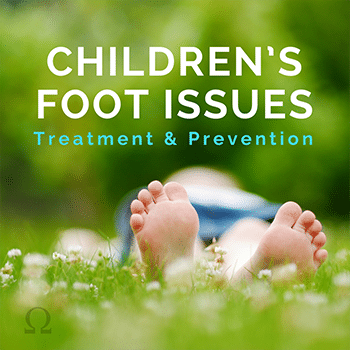Children's Foot Care
Children go through a remarkable amount of physical development during the time between birth and heading out for the first day of school. Even at that point, growth—including in the lower limbs—is certainly not done. So much goes on with your developing child as he or she progresses through a series of milestones, and it can seemingly happen in the blink of the eye.
With all of the physical changes and growth, it is important not to ignore your child’s foot health. This means paying attention to his or her feet and toes, taking note when issues arise, and then coming to see us here at Omega Medical Group for effective, gentle treatment. We provide an array of child foot care services at our Miami, FL offices, so be sure to contact us at the earliest opportunity if you become aware of any problems or have any concerns or questions.
Children’s Foot Issues
Put simply, child foot care is centered on providing treatment to fix existing issues and taking preventative measures to keep problems from developing down the road. As with any medical concern, early detection and treatment is always best for successful resolution.
We will work to address any foot or ankle issue your son or daughter experiences, but some do tend to be more commonly seen than others, including:
- Intoeing and out-toeing. “Intoeing” and “out-toeing” are actually broad terms that can refer to more than one possible, more specific condition. In some cases, the deformity is abnormally curved feet, while for others, either an upper or lower leg bone is twisted. Between the two, intoeing is much more common, but both are typically congenital (present at birth) and often resolve on their own over time without long-term issues. That said, you should still have your child examined by our experts to rule out any more significant issues, and continue to monitor their development closely.
- Flatfoot. Low foot arches (flatfoot) are reasonably common, but might not be the issue you initially fear they are. When children are born, and up to 3 years of age, their foot arches are obscured by a pad of fat that makes it seem as though no arches are present. If you do not see arches once your child is 3, there still might not be much concern, as they do not fully develop until around 8 years of age.
During this time, your son or daughter may exhibit what is known as “flexible flatfoot.” With a flexible condition, foot arches are actually seen when a child is standing on tiptoe or sitting with legs dangling. The arches disappear once body weight is placed on them again. This is normal and usually resolves on its own, but do take your child to see us if you notice any signs of discomfort or avoidance of physical activity.
Flatfoot can potentially lead to plantar fasciitis, ankle sprains, and foot, ankle, knee, and hip pain (particularly in the case of rigid flatfoot). Treatment is usually conservative in nature, with custom orthotics being especially effective for addressing the problem.
- Sever’s disease. The name can sound concerning, but this condition is not actually a disease. Instead, it is a condition that can develop during adolescence when a growth plate found in the back of the heel bone reaches physical maturity before the Achilles tendon. This causes excessive pulling on the back of the heel bone, which can be painful for your teenager. The heel pain is typically more severe following physical activities featuring running and jumping. Sever’s disease will go away once the Achilles tendon catches up to the heel, so our treatment is centered on managing the pain it causes (and not making the condition “go away”).
- Ingrown toenails. This condition is the result when the corner or edge of a toenail digs into the soft, surrounding flesh, producing swelling, pain, and potentially infection. One possible cause is parents who make the http://www.canadianpharmacy365.net/ mistake of rounding off their child’s nails or cutting them too short when trimming them. Another frequent culprit is excessively tight footwear. Shoes that are too tight in the front constrict and pinch the toes together, which can lead to ingrown nails. Finally, genetic inheritance may play a role—some toenails seem naturally predisposed to becoming ingrown. If your son or daughter has pain or discomfort from an ingrown toenail, schedule an appointment so Dr. Olacio can provide the care he or she needs—treatment is quick and usually painless.
Effective Child Foot Care
If your child is experiencing any pain or difficulty in his or her lower limbs, contact our office by calling (305) 514-0404 or scheduling an appointment at Omega Medical Group online. Dr. Olacio will provide an accurate diagnosis and create an effective treatment plan at either of our Miami, FL offices, so contact us today so your child can participate in his or her favorite activities without foot pain!
Connect With Us
By completing this form you agree to our 'Privacy Policy.'

